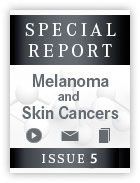BRAF Testing Important for Clinical Decision-Making in Metastatic Melanoma
With the continuously expanding landscape of treatment options for advanced and/or metastatic melanoma, it is becoming increasingly important to understand the patient-specific oncogenic drivers as a means of selecting treatments.
metastatic melanoma

Keith T. Flaherty, MD
The landscape of treatment options for patients with advanced and/or metastatic melanoma continues to expand, with immunotherapies and targeted therapies, as well as combinations thereof, gaining approval in recent years. As such, it is becoming increasingly important to understand the patient-specific oncogenic drivers, as a means of selecting treatments. The current National Comprehensive Cancer Network (NCCN) guidance recognizes the importance ofBRAFtesting (for patients with metastatic disease).1As clinical experience grows with new agents, combinations, and sequences of therapy, the use of molecular profiling in metastatic melanoma is likely to become an essential means of choosing among treatment options.
Evolution of Immunotherapies
Patients with metastatic or unresectable melanoma are now candidates for first-line systemic therapy with antiPD-1 receptor antibodies (Category 1) as monotherapy (pembrolizumab and nivolumab), but targeted therapies are preferred ifBRAFmutated, in cases where an early response is clinically desirable.1Other options include the nivolumab/ipilimumab (antiCTLA-4) combination.1Recent phase III results reported inThe New England Journal of Medicinedemonstrated that the use of nivolumab, an anti-PD-1 agent, either alone or in combination with ipilimumab, an antiCTLA-4 agent, significantly improved median progression-free survival (PFS) compared with ipilimumab alone.2Keith T. Flaherty, MD director of clinical research and of the Henri and Belinda Termeer Center for Targeted Therapies and at Massachusetts General Hospital Cancer Center, notes that a range of treatment options now exist for patients withBRAF-mutationpositive disease.1
Evolution of BRAF-Targeted Therapy
Current NCCN guidance recommends considering targeted therapies for patients withBRAF-mutant melanoma with symptomatic disease, or who progress on immunotherapies.1Vemurafenib was the first targeted therapy to become available for patients with metastatic melanoma, and was shown to improve overall and progression-free survival (PFS) over conventional chemotherapy (dacarbazine), the standard of care at the time.3Vemurafenib is currently approved for use in patients withBRAF-mutationpositive melanoma, as determined by an FDA-approved test (Cobas).4
Subsequently, a second BRAF inhibitor dabrafenib, became available for use after it was shown to also improve PFS compared with dacarbazine.5Adverse events (AEs) associated with these BRAF-targeted therapies include skin toxicities, which were observed in a sizable proportion of patients.3,5-7It now appears that these toxicities stemmed from a paradoxical activation of the MAP kinase pathway by these agents, and these observations, in addition to the propensity to develop resistance to monotherapy, have more recently paved the way for their use in combination with MEK-directed agents in patients withBRAF-mutationpositive disease.8-11
Combination Therapies
Recent phase III trials have established the clinical feasibility of using BRAF inhibitors and MEK inhibitors in combination.10,11One trial combined dabrafenib with the MEK inhibitor trametinib (compared with dabrafenib and placebo) in previously untreated patients with unresectable advanced melanoma harboringBRAFV600EorV600Kmutation.10The results showed significantly improved PFS (primary endpoint, HR = 0.75;P= .03), as well as response and overall survival (OS) for patients receiving the combination versus those receiving the single agent (Table 1).10Notably, the incidence of cutaneous squamous cell carcinoma and cutaneous hyperkeratoses was lower with the combination, although the incidence of other AEs (eg, pyrexia 51% vs 28%) was higher.10In a similarly designed trial comparing vemurafenib combined with the MEK inhibitor cobimetinib with vemurafenib alone, the use of the BRAF/MEK combination therapy also resulted in significantly improved PFS (HR = 0.51;P<.001), response, and interim OS (Table 1), with a similar impact on skin toxicities.11
Table 1: Selected Efficacy and Safety Endpoints in Phase III Trials of BRAF/MEK Inhibitor Combinations10,11
Endpoint
Combination
BRAF Inhibitor
PValue
Dabrafenib/Trametinib vs Dabrafenib/Placebo
PFS
9.3 mo
8.8 mo
0.03
Overall Response
67%
51%
0.002
OS
93%
85%
0.02
Cutaneous Squamous Cell Carcinoma
2%
9%
NR
Cutaneous Hyperkeratoses
3%
32%
NR
Vemurafenib/Cobimetinib vs Vemurafenib/Placebo
PFS
9.9 mo
6.2 mo
<0.001
Overall Response
68%
45%
<0.001
OS
81%
73%
0.046
Cutaneous Squamous Cell Carcinoma *
2%
11%
NR
Cutaneous Hyperkeratoses *
1%
8%
NR
*Grade 3 only is shown
NR, not reported
BRAF Testing: Impact on Treatment Decisions
The rapid and impressive response rates that have been observed with targeted therapies, particularly in combination, thus support the use ofBRAFtesting in metastatic melanoma, in accordance with treatment guidelines, to determine whether or not this set of treatment options applies to a given patient.1The efficacy of immunotherapy appears to be largely independent ofBRAFmutational status, including the recent nivolumab/ipilimumab combination.2Thus, at present,BRAFtesting does not impact treatment decisions with this other line of therapy for malignant melanoma. Jedd D Wolchok, MD, PhD, chief of the Melanoma and Immunotherapeutics Service and Lloyd J. Old Chair for Clinical Investigation at Memorial Sloan Kettering Cancer Center agrees thatBRAFtesting is important to guide targeted treatment but is not necessary for immunotherapy.
Michael Postow, MD, an assistant attending physician in the Melanoma and Immunotherapeutics Service at MSKCC also recognizes the ongoing importance ofBRAFtesting to determine the appropriateness of targeted therapy. “My personal opinion is that, if a patient is choosing among BRAF inhibitor options, they should be offered the combination of dabrafenib plus trametinib, because this combination has been shown to improve overall survival compared with vemurafenib monotherapy, and in a separate trial, to dabrafenib monotherapy.”
As the therapeutic landscape continues to evolve, the role of testing forBRAF(and likely other mutations) may increase further.11,12Indeed, Postow emphasizes that that the issue of optimal sequencing of targeted therapies and immunotherapies remains a very active area of research. “SinceBRAFmutations are very common in melanoma (approximately 50%),BRAFtesting of tumors remains an important part of the management of patients with metastatic melanoma. Additional research is still needed to determine the best sequence of BRAF inhibitors and immunotherapy for patients withBRAF-mutant melanoma.”
Clinical Pearls
- Current options for patients with metastatic melanoma include immunotherapy (nivolumab, ipilimumab) and targeted therapy (vemurafenib, dabrafenib, trametinib), and selected combinations thereof.
- BRAFmutations are observed in approximately 50% of melanomas, and molecular testing is important to distinguish among available treatment options.
- Recent results show combination BRAF/MEK inhibitor therapy is superior to BRAF inhibitor monotherapy in efficacy and selected adverse events;BRAFtesting is needed to determine whether or not patients are appropriate for this therapy.
- Immunotherapy remains an option for patients with metastatic melanoma, and efficacy appears to be largely independent ofBRAFstatus.
- The optimal sequence of BRAF inhibitors and immunotherapy options for patients withBRAFmutant melanoma remains an active area of investigation.
References
- NCCN Clinical Practice Guidelines in Oncology (NCCN Guidelines). Melanoma. www.nccn.org. Accessed October 29, 2015.
- Larkin J, Chiarion-Sileni V, Gonzalez R, et al. Combined nivolumab and ipilimumab or monotherapy in untreated melanoma. N Engl J Med. 2015;373(1): 23-34.
- Chapman PB, Hauschild A, Robert C, et al. Improved survival with vemurafenib in melanoma with BRAF V600E mutation. N Engl J Med. 2011;364:2507-2516.
- Zelboraf (Vemurafenib) Prescribing Information, Genentech USA, Inc.
- Hauschild A, Grob JJ, Demidov L, et al. Dabrafenib in BRAF-mutated metastatic melanoma: a multicentre, open-label, phase 3 randomised controlled trial. Lancet. 2012;380:358-365.
- Sosman JA, Kim KB, Schuchter L, et al. Survival in BRAF V600mutant advanced melanoma treated with vemurafenib. N Engl J Med. 2012;366:707-714.
- Larkin J, Del Vecchio M, Ascierto PA, et al. Vemurafenib in patients with BRAF(V600) mutated metastatic melanoma: an open-label, multicentre, safety study. Lancet Oncol. 2014;15:436-444.
- Oberholzer PA, Kee D, Dziunycz P, et al. RAS mutations are associated with the development of cutaneous squamous cell tumors in patients treated with RAF inhibitors. J Clin Oncol. 2012;30: 316-321.
- Su F, Viros A, Milagre C, et al. RAS mutations in cutaneous squamous-cell carcinomas in patients treated with BRAF inhibitors. N Engl J Med. 2012;366:207-215.
- Long GV, Stroyakovskiy D, Gogas H, et al. Combined BRAF and MEK inhibition versus BRAF inhibition alone in melanoma. N Engl J Med. 2014;371(20):1877-1888.
- Larkin J, Ascierto PA, Dréno B, et al. Combined vemurafenib and cobimetinib in BRAF-mutated melanoma. N Engl J Med. 2014; 371(20):1867-1876.
- Sullivan R, LoRusso P, Boerner S, Dummer R. Achievements and challenges of molecular targeted therapy in melanoma. Am Soc Clin Oncol Educ Book. 2015:177-186.
- Hu-Lieskovan S, Robert L, Homet Moreno B, Ribas A. Combining targeted therapy with immunotherapy in BRAF-mutant melanoma: promise and challenges. J Clin Oncol. 2014; 32(21):2248-2254.

Gasparetto Explains Rationale for Quadruplet Front Line in Transplant-Ineligible Myeloma
February 22nd 2025In a Community Case Forum in partnership with the North Carolina Oncology Association, Cristina Gasparetto, MD, discussed the CEPHEUS, IMROZ, and BENEFIT trials of treatment for transplant-ineligible newly diagnosed multiple myeloma.
Read More
Key Trials From ASH 2024 Impact Treatment for Plasma Cell Disorders Going Forward
February 20th 2025Peers & Perspectives in Oncology editorial board member Marc J. Braunstein, MD, PhD, FACP, discussed the significant advancements in multiple myeloma treatment at the 2024 ASH Annual Meeting and Exposition.
Read More